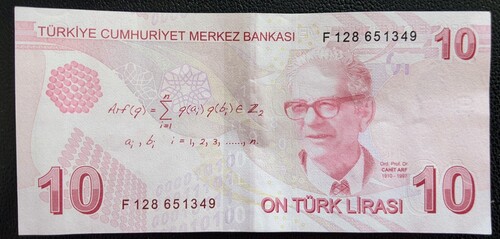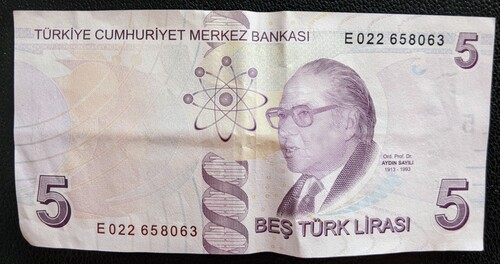 ?Mathematical formulae have been encoded as MathML and are displayed in this HTML version using MathJax in order to improve their display. Uncheck the box to turn MathJax off. This feature requires Javascript. Click on a formula to zoom.
?Mathematical formulae have been encoded as MathML and are displayed in this HTML version using MathJax in order to improve their display. Uncheck the box to turn MathJax off. This feature requires Javascript. Click on a formula to zoom.Abstract
Turkey's 2009 series of banknotes feature six eminent scholarly figures, with at least two of interest to a mathematical audience. We lay these mathematicians within a historical context, and provide a short summary of how they have contributed to the country's promotion and revival of scientific knowledge. Such campaigns lead to an increased awareness for both mathematics and mathematicians in the general audience, and can also be an effective strategy in boosting public opinion of the science, technology, engineering, and mathematics (STEM) disciplines.
During the Turkish celebration of Ramadan in 2023, the first author ( B. S.) was invited by the second author ( Y. A.) for an academic visit to Erzurum supported by The Scientific and Technological Research Council of Türkiye (TÜBİTAK). When Y. A. handed B. S. a ₺10 banknote (see, ), B. S. noticed the inscribed mathematical equation:
(1)
(1) Equation (Equation1
(1)
(1) ) is a special case of the Arf invariant proposed by the mathematician Cahit Arf (1910-1997) whose image also appears on this banknote. This unexpected mathematical delight provided the stimulus for this short note.
In 2009, Turkey introduced the series of ‘E-9 Emission Group’ banknotes that still continue. The six banknotes in denominations of ₺5, ₺10, ₺20, ₺50, ₺100, and ₺200 depict six eminent Turkish scholars. The Central Bank of Turkey provides a description of these personalities (Central Bank of the Republic of Türkiye Head Office Citation2009). In addition to Arf on the ₺10 banknote, the ₺5 banknote (see, ) is interesting to the audience of this journal; we revisit it later.
Sertoz (Citation2013) provides a lucid English-language biography of Arf which draws parallels between Atatürk's idealism of the then recently founded Turkish republic and Arf's academic growth – both boldly seeking new challenges. Born in 1910 in modern-day Thessaloniki, Arf and his family moved to Istanbul in 1912 due to the Balkan War. In 1932, he began teaching mathematics as a school teacher at the Galatasaray High School, Istanbul – the first state school in Turkey where education was imparted in a foreign language (Sertoz Citation2013). Sertöz attributes Arf's decision to become a high-school teacher to both the extremely strong Turkish high-school education system of the time and to Arf's enthusiastic idealism. Later, another prominent Turkish mathematician Kerim Erim (1884–1952) attracted Arf to the university educational system that was uncommon in Turkey at that time (Sertoz Citation2013).Footnote1 And thus encouraged, Arf spent significant academic time in France, Germany, and the US.
Arf returned to Turkey in 1938 and became a professor in 1943. In 1955, he became an ordinarius professor – a title reserved for ‘extraordinary’ professors in Turkey.Footnote2 Inspired by the ₺10 banknote that has made the mathematician a popular Turkish household name, there are dozens of blogs, forums, and interviews available on Internet both in English and Turkish. The Mathematics Department at the Middle East Technical University in Ankara holds Arf Lectures in his honour (Orta Doğu Teknіk Ünіversіtesі Ankara Kampüsü Citation2022).
Like other eminent mathematicians, Arf had a vision of how scientific knowledge would evolve. This is eloquently evident from his 1959 conference paper, titled Makine düşünebilir mi ve nasıl düşünebilir? (‘Can a machine think and how can it think?’), that he delivered as a speech in Erzurum (Arf Citation1959; Kaya Citation2021). It begins with a historical context encouraging Erzurum to be a modern centre of learning by contrasting it to the nearby cosmopolitan city of Tbilisi. Arf continues by saying that to do so people must not blindly follow eminent personalities but rather rely on their own common-sense as a way to scientific growth. Then, Arf lays out his vision of the evolution of artificial intelligence (AI), how complex ‘thinking machines’ (that can be thought of as modern-day computers) would conduct computations, and a comparison of such technologies with the human brain. On the latter point, Arf comments the key difference between human brains and AI is that the latter would never comprehend aesthetics, e.g. appreciate a piece of music. We can only imagine his reaction if he saw the growth, development, and dilemmas faced by the AI-researchers of today.
The ₺5 banknote (see, ) features another eminent scientific personality who was not only a contemporary of Arf but had an analogous life as well – Aydın Sayılı (1913–1993). This man was instrumental in detailing the historical context of several scientific works from the Arabic and Islamic world, especially before the European Renaissance. For Sayılı's life and scientific accomplishments, see the account by the Muslim Heritage (Turker-Kuyel Citation2008) and a eulogy filled with anecdotes (Russell Citation1996).
Born in Istanbul in 1913, Sayılı also spent significant time outside Turkey, especially in the US; Atatürk took a personal interest in sending Sayılı abroad for his education (Russell Citation1996). Sayılı too was influenced by Turkey's political climate of the time: ‘The emotional impact of this period on Sayılı and his generation was inescapable’ (Russell Citation1996). In 1943, he returned to Turkey to work at Ankara University after receiving the world's first doctorate in the history of science. In 1958, he received the prestigious status of an ordinarius professor. Among his seminal contributions to the history of science is his book, The Observatory in Islam, where he meticulously argues that the astronomical observatory as an institution for organized scientific learning originated from Islam, see, e.g. Turker-Kuyel (Citation2008); including the construction of dedicated buildings and employment of own research staff (Russell Citation1996). In addition to the astronomical observatory, Sayılı's works present three other important institutions of scientific learning in Islam: the madrasa, the hospital, and the library (Turker-Kuyel Citation2008).
Sayılı also published extensively about famous early Islamic era mathematicians and philosophers of whom we mention two who are particularly appealing to this journal's audience. First, Sayılı rediscovered a generalization of the Pythagoras theorem proven by the ninth-century scholar Thabit ibn Qurra; Sayılı presented this at the 1956 meeting of the History of Science Society (Sayılı Citation1960).Footnote3 Second, Sayılı published extensively about the tenth-century scholar Abu Nasr Muhammad al-Farabi; see, e.g. the English-language collection (Sayılı Citation1951). Here, his monumental efforts position al-Farabi's works within a historical context by studying the question of authorship of apocryphal works attributed to this phenomenal scholar.Footnote4
Depicting mathematicians on national banknotes is not only socially praiseworthy but also inspiring, especially to younger audiences (Zhdanov Citation2009). In a website maintained by Hung M. Bui at the University of Manchester (Bui Citation2023), we find 28 other historical banknotes featuring mathematicians; all of these are from before the year 2000. The British mathematician Alan Turing was recently featured on UK's £50 banknote; see Odedra and Cooper (Citation2021) for a history of this journey. Such political agenda renders these scientists as luminaries. However, in addition to this iconic status, it brings a positively changing social perception of both mathematics and mathematicians. Indeed, with governments worldwide promoting the science, technology, engineering, and mathematics (STEM) disciplines, such promotion campaigns efficiently serve to improve the public image of mathematics.
Disclosure statement
No potential conflict of interest was reported by the author(s).
Additional information
Funding
Notes
1 Erim is credited for establishing Istanbul University as a leading mathematical centre (Eden and Irzik Citation2012). He is also considered as the first Turkish mathematician to receive a doctorate (Eden and Irzik Citation2012).
2 This title was abolished in 1981. The last ordinarius professor in Turkey, Reşat Kaynar, passed away in 2006.
3 In this presentation, Sayılı mentions that the theorem was rediscovered in the 1937 edition of the book Der Pythagoreische Lehrsats by W. Lietzmann. Four years later, following up on this claim, Boyer (Citation1964) found this theorem was “rediscovered” much earlier in the 1790 edition of the book Recreations Mathematiques et Physiques. We direct the interested reader to Boyer's work (Boyer Citation1964) for this episode riddled with the tale of two brothers and smallpox.
4 Despite a lack of worldwide consensus on authorship of several ancient texts, there is no doubt about al-Farabi's immense legacy to the development of worldwide scientific thought. These contributions are most visibly recognized by the government of Kazakhstan where al-Farabi's image appears on several banknotes from Kazakhstan's 1993 series. A photograph of a 1 Tenge Kazakh note is available in a collection maintained by Bui (Citation2023).
References
- Arf, Cahit, ‘Makine düşünebilir mi ve nasıl düşünebilir?’ in Öğretim Yılı Halk Konferansları, number 1. Atatürk Üniversitesi, 1959, p. 91–103.
- Boyer, Carl B., ‘Clairaut le cadet and a theorem of Thabit ibn Qurra’, Isis, 55(1) (March 1964), 68–70. doi: 10.1086/349796
- Bui, Hung M., ‘Mathematicians and physicists on banknotes’, April 2023. https://personalpages.manchester.ac.uk/staff/hung.bui/Collection/Notes/banknotes.htm.
- Central Bank of the Republic of Türkiye Head Office, ‘Banknote characters on E9 Emission Group Turkish Lira banknotes’, January 2009. https://www.tcmb.gov.tr/wps/wcm/connect/EN/TCMB+EN/Main+Menu/Banknotes/General+Information+on+Banknotes/Banknote+Characters.
- Eden, Alp, and Irzik, Gürol, ‘German mathematicians in exile in Turkey: Richard von Mises, William Prager, Hilda Geiringer, and their impact on Turkish mathematics’, Historia Mathematica, 39(4) (November 2012), 432–459. doi: 10.1016/j.hm.2012.07.002
- Kaya, Mehmet Bedii, ‘Makine düşünebilir mi ve nasıl düşünebilir?’ Cahit Arf, November 2021. https://mbkaya.com/makine-dusunebilir-mi-cahit-arf/.
- Odedra, Raakhi, and Cooper, Stuart, ‘Our new banknotes: The journey from design to launch’, Bank of England Quarterly Bulletin, page Q3, October 2021. URL https://ssrn.com/abstract=3945592.
- Orta Doğu Teknіk Ünіversіtesі Ankara Kampüsü, ‘Cahit Arf Lecture 2022’, October 2022. https://math.metu.edu.tr/en/announcement/cahit-arf-lecture-2022.
- Russell, G A, ‘Eloge: Aydin Sayili, 1913–1993’, Isis, 87(4) (December 1996), 672–675. doi: 10.1086/357653
- Sayılı, Aydın, Fârâbî ve tefekkür tarihindeki yeri, volume 15. Türk Tarіh Kurumu, January 1951. https://belleten.gov.tr/sayi/103#cat-3.
- Sayılı, Aydın, Thâbit ibn Qurra's generalization of the pythagorean theorem', Isis, 51(1) (March 1960), 35–37. doi: 10.1086/348837
- Sertoz, Ali Sinan, ‘A scientific biography of Cahit Arf (1910–1997)’, January 2013. https://arxiv.org/abs/1301.3699.
- Turker-Kuyel, Mubahat, ‘In memoriam of Aydin Sayili: Biography and account of his scientific activity’, October 2008. https://muslimheritage.com/in-memoriam-of-aydin-sayili-biography-and-account-of-his-scientific-activity/.
- Zhdanov, Renad, ‘Scientists on Turkey's banknotes should inspire young minds’, Nature, 457(7232) (February 2009), 956–956. doi: 10.1038/457956a


